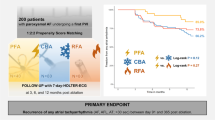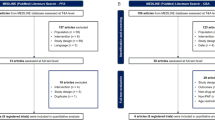Opinion statement
Our approach to the ablation of atrioventricular nodal reciprocating tachycardia (AVNRT), the most common supraventricular tachycardia, is as follows: We first attempt ablation in the right atrial posteroseptum anterior to the coronary sinus ostium with a 4-mm non-irrigated tip catheter. If ablation within the triangle of Koch is unsuccessful with radiofrequency (RF), we switch to cryoablation and target a more superior (mid septal) region. We also utilize cryoablation if RF ablation produces transient VA block (absence of retrograde conduction during junctional rhythm) or a fast junctional rhythm (<350 msec). If cryoablation were to fail, or is not available, we would then suggest ablation within the coronary sinus targeting the roof (2–4 cm from the os) using a 3.5-mm irrigated tip catheter. If tachycardia were still inducible despite these measures, we would then proceed with transseptal puncture (given our greater experience with this over a retrograde aortic approach) and perform RF ablation along the posteroseptal left atrium and inferoseptal mitral annulus utilizing an irrigated tip catheter. In our experience, cryoablation reliably results in elimination of the slow pathway. The only left atrial ablation for AVNRT at our institution in the past year was performed because a patent foramen ovale allowed for rapid left atrial access, facilitating left atrial ablation of the slow pathway.


Similar content being viewed by others
References and Recommended Reading
Papers of particular interest, published recently, have been highlighted as: • Of importance •• Of major importance
Moe GK, Preston JB, Burlington H. Physiologic evidence for a dual A-V transmission system. Circ Res. 1956;4(4):357–75.
•• Page RL, Joglar JA, Caldwell MA, Calkins H, Conti JB, Deal BJ, Estes 3rd NA, Field ME, Goldberger ZD, Hammill SC, Indik JH, Lindsay BD, Olshansky B, Russo AM, Shen WK, Tracy CM, Al-Khatib SM. 2015 ACC/AHA/HRS guideline for the management of adult patients with supraventricular tachycardia: a report of the American College of Cardiology/American Heart Association Task Force on Clinical Practice Guidelines and the Heart Rhythm Society. J Am Coll Cardiol. 2016;67(13):e27–e115. doi:10.1016/j.jacc.2015.08.856. Most recent SVT guidelines which outline nicely the diagnostic and treatment options available for AVNRT including non-invasive and invasive modalities
Gallagher JJ, Svenson RH, Kasell JH, German LD, Bardy GH, Broughton A, Critelli G. Catheter technique for closed-chest ablation of the atrioventricular conduction system. N Engl J Med. 1982;306(4):194–200.
Scheinman MM, Morady F, Hess DS, Gonzalez R. Catheter-induced ablation of the atrioventricular junction to control refractory supraventricular arrhythmias. JAMA. 1982;248(7):851–5.
Epstein LM, Scheinman MM, Langberg JJ, Chilson D, Goldberg HR, Griffin JC. Percutaneous catheter modification of the atrioventricular node. A potential cure for atrioventricular nodal reentrant tachycardia. Circulation. 1989;80(4):757–68.
Jackman WM, Beckman KJ, McClelland JH, Wang X, Friday KJ, Roman CA, Moulton KP, Twidale N, Hazlitt HA, Prior MI, et al. Treatment of supraventricular tachycardia due to atrioventricular nodal reentry, by radiofrequency catheter ablation of slow-pathway conduction. N Engl J Med. 1992;327(5):313–8.
Sporton SC, Earley MJ, Nathan AW, Schilling RJ. Electroanatomic versus fluoroscopic mapping for catheter ablation procedures: a prospective randomized study. J Cardiovasc Electrophysiol. 2004;15(3):310–5.
Kopelman HA, Prater SP, Tondato F, Chronos NA, Peters NS. Slow pathway catheter ablation of atrioventricular nodal re-entrant tachycardia guided by electroanatomical mapping: a randomized comparison to the conventional approach. Europace. 2003;5(2):171–4.
Scaglione M, Ebrille E, Caponi D, Blandino A, DI Donna P, Siboldi A, Bertero G, Anselmino M, Raimondo C, Sardi D, Gabbarini F, Marasini M, Gaita F. Single center experience of fluoroless AVNRT ablation guided by electroanatomic reconstruction in children and adolescents. Pacing Clin Electrophysiol. 2013;36(12):1460–7. doi:10.1111/pace.12183.
Iakobishvili Z, Kusniec J, Shohat-Zabarsky R, Mazur A, Battler A, Strasberg B. Junctional rhythm quantity and duration during slow pathway radiofrequency ablation in patients with atrioventricular nodal re-entry supraventricular tachycardia. Europace. 2006;8(8):588–91.
Jentzer JH, Goyal R, Williamson BD, Man KC, Niebauer M, Daoud E, Strickberger SA, Hummel JD, Morady F. Analysis of junctional ectopy during radiofrequency ablation of the slow pathway in patients with atrioventricular nodal reentrant tachycardia. Circulation. 1994;90(6):2820–6.
Wagshal AB, Crystal E, Katz A. Patterns of accelerated junctional rhythm during slow pathway catheter ablation for atrioventricular nodal reentrant tachycardia: temperature dependence, prognostic value, and insights into the nature of the slow pathway. J Cardiovasc Electrophysiol. 2000;11(3):244–54.
Lipscomb KJ, Zaidi AM, Fitzpatrick AP, Lefroy D. Slow pathway modification for atrioventricular node re-entrant tachycardia: fast junctional tachycardia predicts adverse prognosis. Heart. 2001;85(1):44–7.
Hsieh MH, Chen SA, Tai CT, Yu WC, Chen YJ, Chang MS. Absence of junctional rhythm during successful slow-pathway ablation in patients with atrioventricular nodal reentrant tachycardia. Circulation. 1998;98(21):2296–300.
Strickberger SA, Tokano T, Tse HF, Kim MH, Oral H, Flemming M, Pelosi F, Michaud GF, Knight BP, Goyal R, Morady F. Target temperatures of 48 degrees C versus 60 degrees C during slow pathway ablation: a randomized comparison. J Cardiovasc Electrophysiol. 1999;10(6):799–803.
Knight BP, Ebinger M, Oral H, Kim MH, Sticherling C, Pelosi F, Michaud GF, Strickberger SA, Morady F. Diagnostic value of tachycardia features and pacing maneuvers during paroxysmal supraventricular tachycardia. J Am Coll Cardiol. 2000;36(2):574–82.
Skanes AC, Dubuc M, Klein GJ, Thibault B, Krahn AD, Yee R, Roy D, Guerra P, Talajic M. Cryothermal ablation of the slow pathway for the elimination of atrioventricular nodal reentrant tachycardia. Circulation. 2000;102(23):2856–60.
Deisenhofer I, Zrenner B, Yin YH, Pitschner HF, Kuniss M, Grossmann G, Stiller S, Luik A, Veltmann C, Frank J, Linner J, Estner HL, Pflaumer A, Wu J, von Bary C, Ucer E, Reents T, Tzeis S, Fichtner S, Kathan S, Karch MR, Jilek C, Ammar S, Kolb C, Liu ZC, Haller B, Schmitt C, Hessling G. Cryoablation versus radiofrequency energy for the ablation of atrioventricular nodal reentrant tachycardia (the CYRANO study): results from a large multicenter prospective randomized trial. Circulation. 2010;122(22):2239–45. doi:10.1161/CIRCULATIONAHA.110.970350.
Rivard L, Dubuc M, Guerra PG, Novak P, Roy D, Macle L, Thibault B, Talajic M, Khairy P. Cryoablation outcomes for AV nodal reentrant tachycardia comparing 4-mm versus 6-mm electrode-tip catheters. Heart Rhythm. 2008;5(2):230–4. doi:10.1016/j.hrthm. 2007.10.013.
Nakagawa H, Jackman WM. Catheter ablation of paroxysmal supraventricular tachycardia. Circulation. 2007;116(21):2465–78. Review
Aoyama H, Nakagawa H, Pitha JV, Khammar GS, Chandrasekaran K, Matsudaira K, Yagi T, Yokoyama K, Lazzara R, Jackman WM. Comparison of cryothermia and radiofrequency current in safety and efficacy of catheter ablation within the canine coronary sinus close to the left circumflex coronary artery. J Cardiovasc Electrophysiol. 2005;16(11):1218–26.
Reddy VY, Shah D, Kautzner J, Schmidt B, Saoudi N, Herrera C, Jaïs P, Hindricks G, Peichl P, Yulzari A, Lambert H, Neuzil P, Natale A, Kuck KH. The relationship between contact force and clinical outcome during radiofrequency catheter ablation of atrial fibrillation in the TOCCATA study. Heart Rhythm. 2012;9(11):1789–95. doi:10.1016/j.hrthm.2012.07.016.
Otomo K, Okamura H, Noda T, Satomi K, Shimizu W, Suyama K, Kurita T, Aihara N, Kamakura S. Left-variant: atypical atrioventricular nodal reentrant tachycardia: electrophysiological characteristics and effect of slow pathway ablation within coronary sinus. J Cardiovasc Electrophysiol. 2006;17(11):1177–83.
Green J, et al. “Left ventricular” AV nodal reentrant tachycardia: case report and review of the literature. Heart Rhythm Case Reports. 2016;2(5):367–71.
Pasquié JL, Scalzi J, Macia JC, Leclercq F, Grolleau-Raoux R. Long-term safety and efficacy of slow pathway ablation in patients with atrioventricular nodal re-entrant tachycardia and pre-existing prolonged PR interval. Europace. 2006;8(2):129–33.
Li YG, Grönefeld G, Bender B, Machura C, Hohnloser SH. Risk of development of delayed atrioventricular block after slow pathway modification in patients with atrioventricular nodal reentrant tachycardia and a pre-existing prolonged PR interval. Eur Heart J. 2001;22(1):89–95.
Natale A, Greenfield RA, Geiger MJ, Newby KH, Kent V, Wharton JM, Kearney MM, Brandon MJ, Zimerman L. Safety of slow pathway ablation in patients with long PR interval: further evidence of fast and slow pathway interaction. Pacing Clin Electrophysiol. 1997;20(6):1698–703.
Bailin SJ, Korthas MA, Weers NJ, Hoffman CJ. Direct visualization of the slow pathway using voltage gradient mapping: a novel approach for successful ablation of atrioventricular nodal reentry tachycardia. Europace. 2011;13(8):1188–94. doi:10.1093/europace/eur112.
Malloy L, Law IH, Von Bergen NH. Voltage mapping for slow-pathway visualization and ablation of atrioventricular nodal reentry tachycardia in pediatric and young adult patients. Pediatr Cardiol. 2014;35(1):103–7. doi:10.1007/s00246-013-0748-7.
Heydari A, Tayyebi M, Jami RD, Amiri A. Role of isoproterenol in predicting the success of catheter ablation in patients with reproducibly inducible atrioventricular nodal reentrant tachycardia. Tex Heart Inst J. 2014;41(3):280–5. doi:10.14503/THIJ-13-3332.
Lindsay BD, Chung MK, Gamache MC, Luke RA, Schechtman KB, Osborn JL, Cain ME. Therapeutic end points for the treatment of atrioventricular node reentrant tachycardia by catheter-guided radiofrequency current. J Am Coll Cardiol. 1993;22(3):733–40.
Eckhardt LL, Leal M, Hollis Z, Tanega J, Alberte C. Cryoablation for AVNRT: importance of ablation endpoint criteria. J Cardiovasc Electrophysiol. 2012;23(7):729–34. doi:10.1111/j.1540-8167.2011.02289.x.
De Sisti A, Tonet J, Amara W, Raguin D, Aouate P, Gueffaf F, Touil F, Hidden-Lucet F. Correlations between long-term results after cryoablation for atrioventricular nodal reentry tachycardia and a residual jump associated or not with a single echo. Europace. 2012;14(2):261–6. doi:10.1093/europace/eur297.
• Katritsis DG, Zografos T, Katritsis GD, Giazitzoglou E, Vachliotis V, Paxinos G, Camm AJ, Josephson ME. Catheter ablation vs. antiarrhythmic drug therapy in patients with symptomatic atrioventricular nodal re-entrant tachycardia: a randomized, controlled trial. Europace. 2016 May 12. pii: euw064. A small but recent randomized control trial citing the safety and efficacy for choosing ablation over antiarrhythmic drug therapy for the treatment of AVNRT.
Chimienti M, Cullen Jr MT, Casadei G. Safety of flecainide versus propafenone for the long-term management of symptomatic paroxysmal supraventricular tachyarrhythmias. Report from the Flecainide and Propafenone Italian Study (FAPIS) Group. Eur Heart J. 1995;16(12):1943–51.
Wanless RS, Anderson K, Joy M, Joseph SP. Multicenter comparative study of the efficacy and safety of sotalol in the prophylactic treatment of patients with paroxysmal supraventricular tachyarrhythmias. Am Heart J. 1997;133(4):441–6.
Gambhir DS, Bhargava M, Nair M, Arora R, Khalilullah M. Comparison of electrophysiologic effects and efficacy of single-dose intravenous and long-term oral amiodarone therapy in patients with AV nodal reentrant tachycardia. Indian Heart J. 1996;48(2):133–7.
Musto B, D'Onofrio A, Cavallaro C, Musto A, Della Gatta O, Marsico F. Electrophysiological effects and clinical efficacy of flecainide in childhood patients with supraventricular reciprocating paroxysmal tachycardia. G Ital Cardiol. 1987;17(5):444–9. Italian
Kohli V. Oral flecainide is effective in management of refractory tachycardia in infants. Indian Heart J. 2013;65(2):168–71. doi:10.1016/j.ihj.2013.02.009.
Calkins H, Yong P, Miller JM, Olshansky B, Carlson M, Saul JP, Huang SK, Liem LB, Klein LS, Moser SA, Bloch DA, Gillette P, Prystowsky E. Catheter ablation of accessory pathways, atrioventricular nodal reentrant tachycardia, and the atrioventricular junction: final results of a prospective, multicenter clinical trial. The Atakr Multicenter Investigators Group. Circulation. 1999;99(2):262–70.
• Santangeli P, Proietti R, Di Biase L, Bai R, Natale A. Cryoablation versus radiofrequency ablation of atrioventricular nodal reentrant tachycardia. J Interv Card Electrophysiol. 2014;39(2):111–9. doi:10.1007/s10840-013-9842-2. Large meta-analysis consisting of 2340 patients comparing radiofrequency ablation to cryo ablation of AVNRT showing lower recurrence with RF but with a higher risk of permanent AV block
• Hanninen M, Yeung-Lai-Wah N, Massel D, Gula LJ, Skanes AC, Yee R, Klein GJ, Manlucu J, Leong-Sit P. Cryoablation versus RF ablation for AVNRT: a meta-analysis and systematic review. J Cardiovasc Electrophysiol. 2013;24(12):1354–60. doi:10.1111/jce.12247. Another large meta-analysis consisting of 5617 patients comparing radiofrequency ablation to cryo ablation of AVNRT showing similar results to the trial by Santangeli et al where a lower risk of recurrence with RF comes at the expense of a slightly higher risk of AV block
Author information
Authors and Affiliations
Corresponding author
Ethics declarations
Conflict of Interest
Darpan S. Kumar, Thomas A. Dewland, and Charles A. Henrikson each declare no potential conflicts of interest.
Seshadri Balaji reports a research grant from Medtronic for research on pediatric hypertophic cardiomyopathy.
Human and Animal Rights and Informed Consent
This article does not contain any studies with human or animal subjects performed by any of the authors.
Additional information
This article is part of the Topical Collection on Arrhythmia
Rights and permissions
About this article
Cite this article
Kumar, D.S., Dewland, T.A., Balaji, S. et al. How to Approach Difficult Cases of AVNRT. Curr Treat Options Cardio Med 19, 34 (2017). https://doi.org/10.1007/s11936-017-0531-9
Published:
DOI: https://doi.org/10.1007/s11936-017-0531-9




